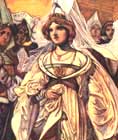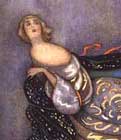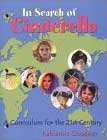
Cinderella:
345 Variants
by Marian
Roalfe Cox
SurLaLune's
Cinderella Area
SurLaLune Fairy Tales Main Page
228
Athanas'ev, Russian Folk-Tales. Moscow, 1861. Part VI. No. LV. Pp. 273-276.
"BURENUSHKA."
ABSTRACT
Ill-treated heroine (by step-mother)--Menial heroine (minds cow)--Helpful animal (cow)--Heroine bows to cow's right foot and obtains food--One-eyed step-sister sent to spy; put to sleep by magic formula during hairdressing. Two-eyed step-sister, the same. Three-eyed step-sister sees with third eye, which heroine omits to charm--Slaying of helpful animal--Heroine buries entrails in door-post; magic shrub springs up covered with sweet berries. Birds sit in its branches--Prince Ivan will wed girl who can fill cup with berries. Birds drive away three step-sisters; pluck the berries for heroine--Happy marriage--Heroine, after birth of son, visits father, Step-mother transforms heroine into goose; substitutes own daughter as prince's wife--Nurse, an old man, takes child into field in early morning; inquires of flock of wild geese if they have seen child's mother. Goose alights, doffs feather-skin, and suckles child; says she may only return once more. Nurse reports to prince, who watches next morning from behind bush; burns feather-skin; seizes wife, who changes into frog, lizard, snake, distaff. Prince breaks distaff into two, throws half behind, half in front of him. Heroine stands before him-- Princes and counsellors assembled to decide with which wife prince must live. He will keep whichever wife climbs palace gates first. Heroine cannot climb. Prince shoots false wife on top of gates. Villain Nemesis.
TABULATION
(1) In a certain kingdom lives a king with his wife and his daughter Mary. When queen dies king marries again. Stepmother has two daughters, one with two eyes, one with three eyes, and she ill-treats Mary, sending her to mind the spotted cow with only a piece of dry bread to eat.-- (2) When she is in the field heroine bows to the right foot of the cow, and then there is plenty of food for her. She takes the piece of bread back home and puts it on the table.-- (3) Queen is very much surprised; gives her same piece of bread next day, and sends one of her daughters to discover whence Mary gets food. When they reach the field Mary says: "Let us sit here. I will comb your hair." Whilst doing so she repeats, "Sister dear, go to sleep Little eye, sleep Second eye, sleep likewise!" Stepsister falls asleep, whereupon Mary bows to cow's right foot and gets food as before. In the evening Mary calls out, "Get up it is time to go home." "Oh dear! oh dear! I have slept all day and seen nothing. Mother will be so angry." On their return mother asks, ''Well, what did Mary eat?" Girl cannot tell her.-- (4) Following day queen sends three-eyed daughter to spy. Same thing happens, but the third eye stays awake and sees everything. Girls return, and step-sister tells queen everything she has witnessed.-- (5) Queen orders cow to be slain, and it is done. Mary asks for a portion of the entrails, and buries it in the door-post. A shrub (cytisus) grows from it, covered with sweet berries. Birds sit in its branches, singing.-- (6) When Prince Ivan hears of it, he comes to the queen, puts a cup on the table, and says, "I will marry the girl who can fill this cup with berries." Stepmother sends eldest daughter, hut the birds will not allow her to touch the berries. She sends second daughter with like result. At last she allows Mary to try, and the moment she approaches the bush the birds begin to pluck the berries and fill her cup.-- (7) Prince Ivan therefore marries heroine. In the course of time Princess Mary has a son, and she goes with husband to visit her father.-- (8) Stepmother changes Mary into a goose and substitutes eldest daughter as Prince Ivan's wife.1 They return to prince's home.-- (9) Very early in the morning the nurse, an old man, takes the child in his arms, and goes into the field. A flock of geese fly past, and he says to them. "Geese, have you seen this child's mother?" One of the geese alights on the ground, takes off its feather-skin, lifts the child in her arms, and begins to suckle it.2 She weeps, and as she weeps she says, "To-day, my loved one, I shall suckle you, to-morrow also, but on the third day, alas! I shall fly, fly away." Then the old man returns home, and the child sleeps the whole day without waking. The pretended mother says: "The old man must have let the child die of hunger."-- (10) Next morning old man takes child to the field as usual. On this occasion Prince Ivan watches him from behind bush. Some wild geese are passing, and old man asks if they have seen child's mother. They answer: "In the second flock." Second flock passes, and old man asks again. Then mother descends, takes off feather-dress, and begins to suckle child, and doing so bursts into tears, crying, "To-morrow I shall fly far, far away, to dark forests, mid high mountains." Then she says, "Dear me what a peculiar smell there is!" and begins to look for her feather-skin.-- (11) She cannot find it, for Prince Ivan has burnt it. He seizes Mary. In an instant she turns into a frog, then into a lizard, then into a snake, lastly, into a distaff. Prince Ivan breaks the distaff into halves, throws one behind him and one in front, and instantly his young wife stands before him. Then they return house, and the false wife, seeing Mary, cries, "here comes a shameless woman!"-- (12) Prince Ivan assembles other princes and counsellors, and asks them with which of his wives he is bound to live. "Surely," they say, "with the first." "Well, I shall live with whichever wife can the more quickly climb up the gates leading to the palace." Second wife climbs the gates very quickly, but Princess Mary simply tries and fails. Meanwhile Prince Ivan seizes a gun and shoots the woman on the top of the gate. Thenceforward he lives happily with Mary.
NOTES
Note 8
(P. 152.) For "substituted bride", see Arnason, p. 443. Asbjornsen, Tales from the Fjeld, p. 156. Buchon, La Grece continentale, etc., p. 263. Busk, F.-L. R. p. 1, "Filagranata," Nos. 2, 3; and "Palombetta," p 22; p. 40, "The King who goes out to dinner." Callaway, Zulu Tales, p. 120, "Ukcombekcantsini." Campbell, iv, 294. Chambers, 95, 99. Chodzko, p. 315. Cosquin, i, 232; ii, 42, 249. Crane, 58, 338. Dasent, "The Lassie and her Godmother", and "Bushy Bride". Denton, p. 191. Folk-lore Rec., iii, 146. Folk-lore Journal, i, 222; ii, 242; iii, 292. Friis, Lappiske Eventyr, "Haccis-aedne." Geldart, p. 63, "The Knife of Slaughter." Gerle, Volksmärchen der Bohmen, No. 5, "Die goldne Ente." Gonzenbach, No. 13, 33. Grimm, note to No. 21, and Nos. 13, 89, 135, 198. Gubernatis, i, 218; ii, p. 242. Sto. Stefano, No. 13. Hylten-Cavallius, Svenska Folk Sagor, No. 7. Kletke, Märchensaal, i, 167. Legrand, p. 140. Luzel, Legendes, ii, 303. Hahn, No. 28. Magyar Folk-tales, pp. 133, 214, 222. Maspons y Labros, Lo Rondallayre, iii, 114, 149. Melusine, 1877, col. 421. Notes and Queries, 7th Series, ii, 104. Pentamerone, "The Three Citrons." Pedroso, Portuguese Folk-tales, "The Maid and the Negress." Pitré, No. 62. Ralston, p. 184, and No. 32. Revue Celtique, 1870, p. 373, "Chat Noir." Rink, Eskimo Tales, p. 310. Rivière, Contes Kabyles, p. 51. Steere, Swahili Tales, p. 398. Stokes, Indian Fairy Tales, pp. xxiii, xxv, 1, 3, 138, 143, 164, 284, 285. Theal, Kaffir Folk-lore, pp. 136, 158. Thorpe, Yule-tide Stories, pp. 47, 54, 61, 62. Webster, pp. 187, 190. Wenzig, Westslavischer Märchenschatz, p. 45.
See also Nos. 8, 10,
29 (69), 95,
101, 102, 187,
228, 231, 233,
242, 243, and 244.
Return to place in text.
Note 9
Dead or transformed mother comes to suckle child. Cf. Altd. Blatter, i, 186. Arnason, "The Troll in the Stone-craft," p. 449. Cosquin, i, 232, 234. Danske Viser, i, 206-208. Grimm, Nos. 11, 13. Monseur, Folklore Wallon (1892), 48 ff., "La Belle et la Laide." Ralston, R. F. T., p. 19, "The Dead Mother." Scott, The Minstrelsy of the Scottish Borders, ii, 223. Theal, Kaffir Folk-lore, pp. 60-1. Tylor, Prim. Cult., i, 411. Compare Melusina.
See also Nos. 95, 101, 228, 235, 242, 243 of this collection.
The following extract bears upon the subject:--
U. JAHN, Volkssagen aus Pommern und Rugen. Stettin, 1886. P. 407.
In the time of the French occupation a girl followed her
lover, a French soldier, from Mellin to Steitin, and soon afterwards returned
to Mellin, and died giving birth to a son. One evening, when the mother
of the deceased was sitting by the child's cradle, she noticed that it
had become unwontedly heavy, and heard a sound as though the child were
sucking. Then she knew that the dead mother had come back to quiet her
child. (From Mesow, in the district of Regenwald. Communicated through
Professor E. Kuhn.
Return to place in text.
Cox, Marian Roalfe. Cinderella: Three Hundred and Forty-five Variants of Cinderella, Catskin, and Cap O' Rushes, abstracted and tabulated. London: David Nutt for the Folklore Society, 1893.
While the original text of this book is out of copyright, the special formatting and compilation available on SurLaLune Fairy Tales is copyrighted. Be aware that while the original content has been honored, page numbering, footnote numbering, redesigned charts, links, and other aspects are unique to this site's version of the text. Use at your own risk. For private and fair use educational purposes only.
©Heidi
Anne Heiner, SurLaLune Fairy Tales
E-mail: surlalune@aol.com
Page last updated February 1, 2006
www.surlalunefairytales.com










